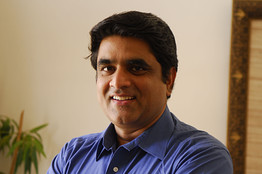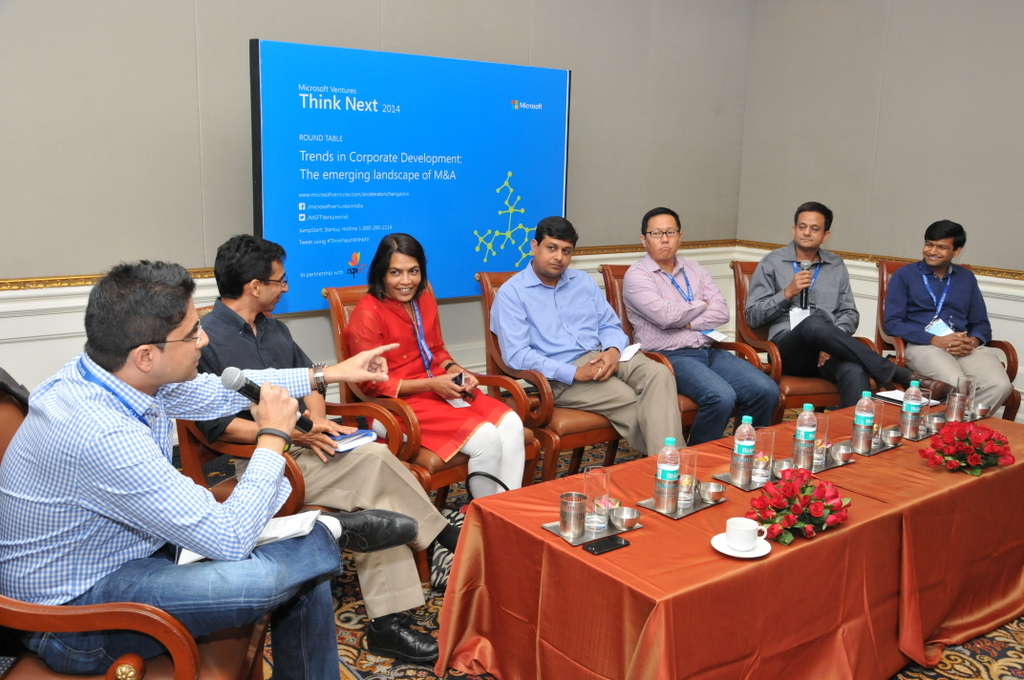ThinkInvestor is iSPIRT and ProductNation’s new initiative to serve as a catalyst between Venture Capital firms, Angels, Angel Networks and Entrepreneurs. It is to go beyond brochure ware and dig deeper into the whole life cycle of a typical investment; from introductions, funding, styles of on-going engagement, to exits. And in the process, capture their views on global and local trends, and the entrepreneurial ecosystem in India.
Seedfund is an early-stage venture capital fund, with operations in Bombay, Bangalore and New Delhi. Seedfund was founded in 2006 by Bharati Jacob, Mahesh Murthy and Pravin Gandhi and the team has grown to include Paula Mariwala, Sanjay Anandaram, Sarabjeet Singh, Shailesh Vickram Singh and Tarana Lalwani. All Seedfund team members have been entrepreneurs at some point or the other in their careers. Seedfund investees include AFAQS, CarWale, Chumbaka, EduSports, Fetise, Frontier Markets, Healthizen, Heckyl, Ixsight, Jeevanti Healthcare, Jeeves, Level10 Comics, Lifeblob, myDentist, Nevales Networks, Printo, redBus, RupeeTalk, Sportskeeda, ThinkLabs, Uhuroo and Vaatsalya.

ProductNation sat down with Sanjay Anandram, Venture Partner of Seedfund for this interview.
Here’s what we heard :
What is Seedfund? Tell us a little bit about your fund, stage, investments you like? How are you structured? What’s your current fund? How far along are you in your current fund?
The name Seedfund implies only seed funding but really is a seed or early stage fund that likes to get in early and stays on through multiple rounds of funding. We can invest up to $5M in a company. The sector is India Domestic Consumption – anything that the Indian consumer spends money on; financial services, entertainment, travel, hospitality, healthcare, education, etc,. We are structured like a regular VC fund. Our first fund was a small $15M fund but our second and current fund is $55M. The first fund is nearing its end of life and the second fund is about 2 years and 10 months old.
How do you get to know companies and entrepreneurs? What’s the best way for an entrepreneur to get in touch with you?
 We are less driven by broad trends than by the specific opportunity and the category we find them in. In many cases, we have invested in companies that created a whole new category. For example, when we invested in redBus, there was no category called Bus Ticketing Services but they created one! Our investment in Vaatsalya created a category called Hospital Chains for Tier 2 and Tier 2 towns. Our investment EduSports created a category for Physical Education Services for schools. Sportskeeda is a Sports Online Community site. All these have been started by people completely embedded in that space.
We are less driven by broad trends than by the specific opportunity and the category we find them in. In many cases, we have invested in companies that created a whole new category. For example, when we invested in redBus, there was no category called Bus Ticketing Services but they created one! Our investment in Vaatsalya created a category called Hospital Chains for Tier 2 and Tier 2 towns. Our investment EduSports created a category for Physical Education Services for schools. Sportskeeda is a Sports Online Community site. All these have been started by people completely embedded in that space.
We have a large network and many companies and entrepreneurs we get to know through referrals. We also have a number of companies approaching us directly also. I started in 1999 an online magazine aimed at entrepreneurs. In 2002 I started one of India’s first VC fund called Jumpstartup. Since 2006 I have been associated with Seedfund as a venture partner. All of this means that we have been long enough in this space to build a large network and get to know people. That’s how we get a lot of referrals and many of them come in directly as well, through email for example.
How long does it take for you to do the due diligence process? What is your due diligence process?
At the stage of the companies we are dealing with, there is usually not a lot of due diligence we could do because many of our portfolio companies create their own categories. That said, we place a few phone calls to check out the space a company is in, any competition they may have. Apart from the usual things like checking out the team, sometimes, we may need to clean up existing company structures if they have involved a lot of friends and family investments. Sometimes companies need time to pull things together for us to do due diligence. All of these typically take from about 3 to 5 weeks time.
What kinds of interesting new categories are you seeing in India? Exciting business models, technologies?
There are two ways to look at the categories we see – one could be the mode of delivery – cloud, mobile, SaaS, etc. The other is along verticals that correspond to consumption of the Indian consumer – financial services, education, healthcare, entertainment, travel. The interesting companies we are seeing deliver something faster, better, cheaper to the Indian consumer in these verticals using one of these delivery methods.We are not seeing a lot of fundamental technology advancement plays from India. We are seeing more innovations in Business Models, throwing together unusual methods of delivery being the innovations.
Although we are focused on the Indian market we have invested in a company like Heckyl that provides financial analytics that includes social media targeted towards brokers and traders. This company has international markets in its scope.
We are very excited about Chumbak, a designer, a brand and a retailer that does India designed Motifs and colors. They have a presence in Japan, have retail stores also in addition to the online one and growing extraordinarily well. Chumbak is creating a brand new category for Indian designed, Indian made products.
AxisRooms is a one of a kind cloud-based start up in the hospitality industry. It enables an exchange for price and inventory discovery to bring together agents and consumers in the hospitality industry with hotels in real-time. Till now there has never been a single place where all travel agents, consumers and hotels can interact, transact business, and get contracts done.
Sports advertising market is about $800M in size and growing at 25% per year. Sportskeeda is right in the middle of this market to serve consumers with a multi-sport content and community platform. Jeeves is a portal for in-warranty, extended warranty and out-of-warranty appliance repair in India.
What caught your attention about redBus? Any stories or interesting pivots you want to share about that company?
There are a few remarkable things about redBus. They proved that you can build a large company in a very ethical way, focusing only on the Indian market, and building a strong consumer brand without splurging money on marketing and advertising. They also proved that it is possible to create a category by co-opting all the players – the bus operators, consumers, ticketing agents and the Government. It wasn’t easy at all; they had lots of roadblocks but they overcame all those! They made a high-end service possible for the end consumer and at the same time, made it transparent to the bus operators how much money they can make by using redBus, and where their weak points were with consumer feedback. Now a lot of the bus operators’ growth is tied to redBus’ growth and vice-versa, a symbiotic relationship! It was a very unorganized, unprofessional, not transparent business. redBus made it a transparent, democratized one!
Here’s an not often mentioned story about redBus: It was one of those early days when they were selling 30 to 40 tickets a day which was really, really small. As happens in small start up companies the co-founders were helping man the customer service phone lines one evening. They got a very angry call from a customer whose Bangalore to Mumbai bus was cancelled and he was stranded in the middle of nowhere with his luggage! It was late at night and Phani, and one of his other co-founders got on their motorbikes and met this irate customer where he was. From there they took him and his luggage on their motorbikes to Bangalore airport, bought him a ticket on a late night Air-India flight to Mumbai and saw him off! Although they were not directly responsible since the bus operator was the one that cancelled the bus, they took it upon themselves to make sure that their customer was treated right! The customer reached Mumbai, wrote them a nice letter thanking them for their service and has been a loyal customer since!
Another remarkable thing about redBus is their commission structure for the tickets they sell for large bus operators and smaller ones. It has been the same and they have resisted lowering it for larger operators that bring them more business or increasing it for smaller operators that don’t bring them that much! It is always a standard transparent one for all of the operators. They have done this in spite of intense pressure from larger and smaller operators alike! Over time everyone understood the value of a transparent, consistent commission structure.
The point I am trying to make is that it is possible to conduct business in India this way – ethical, fair, transparent and consistent!
Once you have invested in a company, what’s your engagement model? How do you interact with these companies?
It’s informal and easy-going (but not at all lax). We focus more on helping the portfolio companies build their business rather than manage from spreadsheets. We focus on strategies and tactics for the company; hiring, customers, business model tweaks, what would the next round of financing look like, partnerships they need to create, what kinds of mentors and advisers they need to bring on board, etc,. We see ourselves as partners rather than investors who write a check, and disappear.
There are formal board meetings with the companies on a pre-arranged calendar. Beyond this the informal interactions are all driven by the entrepreneur needing us to help with something. We share interesting anecdotes, articles, meeting minutes, etc,. Apart from these, we do have CEO meetups a few times a year where they share problems, solutions, experiences, lessons learned, especially in the areas of hiring, sales, etc,.
Let’s move to exits! How do you help them prepare for exits? Do you prepare them for exits?
We believe that you build a good company the exits will suggest themselves automatically! CarWale built a good business around a portal for buying and selling new and used automobiles. The German group Axel Springer and the India Today group did an acquisition. With redBus we were out raising funds when the Naspers group came along and acquired it.
There is no general preparations for exits. Our responsibility as investors is to see the company grow and if they grow well, exits will happen automatically.
What are your thoughts on what’s happening in India? Advice for entrepreneurs and start ups? What’s your advice for people leaving stable jobs for start ups?
There is a lot of activity in India currently. However, we advise entrepreneurs not to get too excited after reading TechCrunch and things happening in Silicon Valley! You need to be excited about opportunities that happen in India! There are enough problems to be solved right here. The customers are here, you can build partnerships here. It is important to be grounded and present in the market for you to build something worthwhile. It is possible to build big, interesting companies, businesses right here in India. But for that to happen, you really need to understand the customer problem you are solving and why they would write a check for your business. A lot of youngsters get excited about what’s going on in Silicon Valley. But you should be spurred by customer problems here, not what’s happening in some other market.
You don’t do a start up because you want another job. Not for sex appeal or the glamour! You do it for the passion. You do it because you want to do it! You may need to get used to downsizing your life significantly. You may not have the same compensation and others things that go with a stable corporate job. You may need to deal with social pressures because your friend continues in a corporate job and has bought a brand new house and a Mercedes recently! I have written extensively about these economic and social pressures, why should you be an entrepreneur, and should you be an entrepreneur. When your passion to go out and do something is greater than the analytical assessment of all these costs, you should do it! You will have to deal with a lot of emotional issues such as self-esteem.
Think of all the possibilities! Don’t let constraints come in the way! It is easy to blame the ecosystem, the lack of money, VCs, Angel Investors, etc,. This question is like asking Is it possible to climb Mt.Everest? Yes. It’s always possible. The key questions are what is required to make it happen? You need to be physically fit, you need to know the lay of the land, you need to have people who have knowledge and experience with doing it before, you need to have the right equipment, a timeline that is suitable and all other resources for such an expedition to succeed. You need to lay all of these in sequence and execute and in 18 months or so you may be on top of Mt.Everest. Constraint based thinking make us give up too soon when you lack one or more of things that are needed. Entrepreneurs use possibility based thinking to address and overcome these limitations one way or another. That’s the difference!
What’s your take on companies getting Mentors? When should they look for one?
Before answering this question it may be better to get some terminology defined correctly since people tend to use words rather interchangeably.
A Consultant is one you bring in to solve a transient, bounded problem. How do I put in an IT system? How do I do Risk Assessment? How do I design a compensation plan?
An Adviser has a longer term strategic and functional objective. What should my IT Strategy or technology be? How should I be doing my marketing?
A Mentor is a like a coach helping them become better.
In Mahabharata, Krishna tells Arjuna to aim and kill Duryodhana below the waist. That’s a Consultant!
When Krishna give Arjuna advice on how to kill Bheeshma, he’s an Adviser!
Before the battle, Arjuna asks Krishna how he could kill his cousins and grandparents in battle. He’s very conflicted about this. Krishna’s advice then is Mentoring!
It depends upon what the entrepreneur needs. Mentors are needed for high level coaching type of advice. Not for finding customers or helping with this or that. You need to be sure that the problem you have needs a Mentor, not an Adviser and definitely, not a Consultant!
 Last Friday, I hosted the M&A Panel at Microsoft Think Next in Bangalore, with a very interesting setup: 2 VCs, 2 entrepreneurs and 2 Corp Development folks from MNCs. The theme of the discussion was “The way forward for M&A for the Software products out of India”. Our star panel consisted of Ashish Gupta (Helion Ventures), Bharti Jacob (Seedfund), Ken Foo (Autodesk), Prashant Gupta (Microsoft), Sanjay Shah (Invensys Skelta) & Phani Sama (Redbus). We had a marquee audience of VCs from IDG, Lightspeed, Qualcomm, Inventus etc. who contributed their insights and really made the discussion lively!
Last Friday, I hosted the M&A Panel at Microsoft Think Next in Bangalore, with a very interesting setup: 2 VCs, 2 entrepreneurs and 2 Corp Development folks from MNCs. The theme of the discussion was “The way forward for M&A for the Software products out of India”. Our star panel consisted of Ashish Gupta (Helion Ventures), Bharti Jacob (Seedfund), Ken Foo (Autodesk), Prashant Gupta (Microsoft), Sanjay Shah (Invensys Skelta) & Phani Sama (Redbus). We had a marquee audience of VCs from IDG, Lightspeed, Qualcomm, Inventus etc. who contributed their insights and really made the discussion lively!


 We are less driven by broad trends than by the specific opportunity and the category we find them in. In many cases, we have invested in companies that created a whole new category. For example, when we invested in
We are less driven by broad trends than by the specific opportunity and the category we find them in. In many cases, we have invested in companies that created a whole new category. For example, when we invested in 